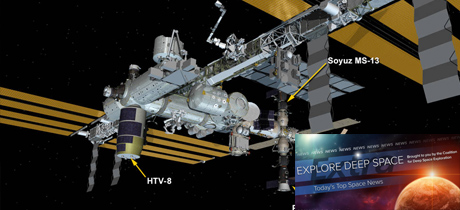In Today’s Deep Space Extra… A bipartisan authorization measure introduced in the U.S. Senate would extend NASA led operations of the International Space Station (ISS) until 2030, providing more time to transition over sight of low Earth activities to the private sector. The bill would also permit the agency to purchase additional seats aboard Russia’s Soyuz for transportation of NASA astronauts to and from the Station, while work to certify Boeing’s CST-100 and SpaceX’s Crew Dragon for the task continues. NASA unseals Apollo era Moon samples for analysis by a new generation of scientists with the latest instrumentation.
Human Space Exploration
New NASA authorization bill would extend ISS to 2030, and INKSNA waiver too
Coalition Members in the News – Boeing, Northrop Grumman
Spacepolicyonline.com (11/6): A bipartisan sponsored NASA authorization measure introduced in the U.S. Senate on Wednesday would direct the agency to extend the life of the International Space Station (ISS) until 2030. It would also extend a waiver of the Iran, North Korea and Syria Nonproliferation Act to allow NASA to purchase Soyuz transportation to the Space Station from Russia from the end of 2020 until 2030 and instruct NASA to prepare an upgraded version of the Space Launch System (SLS) with the Boeing provided Exploration Upper Stage by 2024. The bill also directs development of a lunar landing system through public private partnerships but limits NASA’s procurement to two systems (the agency had sought three.) U.S. Ted Cruz, chair of the Senate Commerce Committee’s space subcommittee, introduced the NASA Authorization Act of 2019 along with cosponsors U.S. Sen. Kyrsten Sinema, of Arizona, as well as the chair and ranking member of the full Senate Commerce Committee, Sens. Roger Wicker, of Mississippi, and Maria Cantwell, of Washington.
Editor’s Note: Yesterday’s Deep Space Extra erroneously described Boeing’s submission to NASA for a Human Landing System as proposing an alternative to the lunar orbiting Gateway. It does not.
Boeing’s rocket contract extension with NASA is good news for regional and local economies
Coalition Members in the News – Boeing, Futuramic
Futuramic.com (11/6): NASA and Boeing have agreed on a contract for the production of 10 Space Launch System (SLS) core stages and up to eight Exploration Upper Stages (EUS) to support future Artemis Missions. Per NASA, the agency intends to work with Boeing, the current lead contractor for the core stages of the rockets that will fly on the first two Artemis missions, for the production of SLS rockets through the next decade.
Mars Society founder makes case for ‘Mars Direct’ path to the Red Planet
Space.com (11/6): As he has for some years, Mars Society founder Robert Zubrin believes that his “Mars Direct” strategy is best to reach the Red Planet with human explorers. The strategy calls for pre-staging of an Earth return spacecraft complete with a nuclear power source on Mars ahead of the launch of astronauts. The initial explorers would remain at Mars for 18 month before making a return. Zubrin spoke before the International Astronautical Congress (IAC) in Washington D.C. last month.
Space Science
NASA opens untouched Apollo moon sample for first time in 40 years
Collectspace.com (11/6): This week, scientists in the Lunar Curation Laboratory at NASA’s Johnson Space Center (JSC) unsealed a sample of lunar material returned to Earth by Apollo era astronauts for the first time in more than 40 years. The exercise is to enable scientists to practice new study techniques in preparation for the return of lunar samples from NASA’s accelerated return to the lunar surface with human explorers in 2024 and to introduce new generations of scientists to the experience. The sample unsealed on Tuesday was returned by Apollo 17 Moon walkers, the late Gene Cernan and Jack Schmitt. Another sample is to be unsealed in January. Both samples came from a two foot long “drive tube” forced into the lunar surface by the two astronauts at Lara Crater.
Chandrayaan-2 mission a major feat, says Narendra Modi
Hindustin Times (11/6): Indian Prime Minister Narandra Modi praised those behind the Chandrayaan 2 mission, which attempted to soft land a spacecraft and small rover at the Moon’s south pole. Communication with the Vikram lander was lost during closing minutes of the automated descent. The cause has not been released, but the Chandrayaan 2 lunar orbiter’s mission continues. Modi proclaimed the mission a success because of its value in inspiring curiosity for science among the nation’s youth.
Discovering extraterrestrial life would be slow and uncertain
Space.com (11/6): Perhaps a lengthy effort to affirm the existence of life beyond Earth is a positive, allowing the human race to time to both accept and assess the significance, according to Sara Seager, an MIT astronomer who recently addressed the topic before the International Astronautical Congress (IAC) in Washington D.C.
Other News
SpaceX’s Starship may fly for just $2 million per mission, Elon Musk says
Space.com (11/6): Speaking at the U.S. Air Force Pitch Day earlier this week, SpaceX founder Elon Musk extolled the low fuel costs of launching the company’s reusable Star Ship into Earth orbit with the Super Heavy.
China’s bold space program flourishing
Asia Times (11/5): Chinese President President Xi Jinping envisions achievements in space as an important extension of his country’s national power and influence. The elements include launch, a permanent space station, a dominating influence in cislunar space, a sustained human presence at the Moon, deep space exploration and resource extraction from asteroids.

